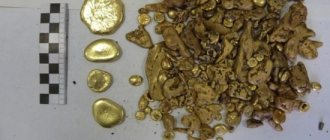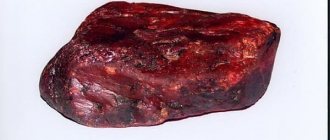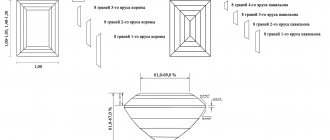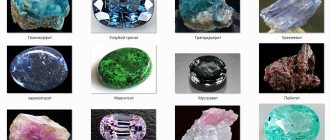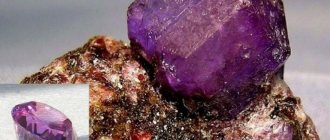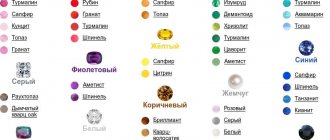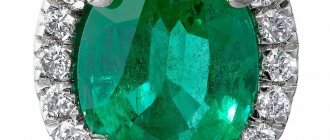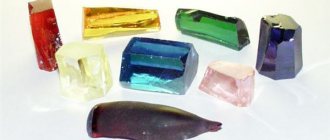Origin of the weight measure
The name came about through the successive transformation of the Arabic word "qirat" into the ancient Greek ceration, and then into the Italian carato. All these names mean the same thing - pod ceratonia, the brown seeds of which at the dawn of our era were used as a measure of mass, approximately equal to 189 mg. The flat seeds of the tree contain a complex polysaccharide, which determines their hardness, as well as the constancy of mass and size. In Ancient Rome, this measure of weight was called siliqua.
Despite the fact that this unit of mass has been known for so long, it was officially adopted only in 1907 at the Paris Conference, where an international treaty was signed, which was the key to the unity of metrological standards in 17 countries. Representatives of Russia were present at the conference, but in the USSR the carat was introduced only in 1922 for use in a narrow jewelry field. Currently, the organization that regulates the rules of metrology classifies this measure of mass as a unit that should be introduced on a limited basis. Another feature of the carat is that decimal prefixes are not applicable to it (for example, you cannot say kilocarat).
Early variations
The unit of mass that is used now did not always exist in this form. The following options were previously used:
- English carat. The history of this unit originates from the ancient gran (gr), based on the weight of an average grain of barley. The English variety of gran was subject to the troy system, and when converted to the one currently used, it was equivalent to approximately 64.799 grams. Accordingly, the carat, calculated as 3 and 17/101 grains, was equal to 205.3 mg. This unit was not indivisible; in everyday life, measures from ¼ to 1/64 carats were used - the so-called jewelry grains.
- Arabic carat (qirat). In Arab countries, the jewelry unit was even more unstable. It was tied to the mithqal and dirham. But since these measures of mass were simultaneously considered monetary units, how many grams are in 1 carat depended on the country. In Iraq the value was 223.2 mg, in Asia Minor - 204 mg, Syria and Mecca - 195 mg. In Egypt, qirat was correlated with local measures of weight, namely shamuna and bakila, and was also equal to 195 mg.
Thus, how much 1 carat weighs also depends on what system of measures it is tied to.
Note
In addition to the carat, jewelers use another unit of measurement – the point. So, 1 carat is equal to 100 points. The weight of the stone is measured with an accuracy of 1 point, which is equal to 1/100 of a carat. It is believed that this unit of measurement was invented in order to bypass the standard metric system. After all, when it comes to diamonds, stones weighing 200 mg or 1 carat are rare, found only once among 250 tons of processed diamond ore.
When buying a diamond, you should know that it is impossible to visually distinguish a stone weighing 0.96 carats from a specimen weighing 1.02 carats. But the price of the former will be half that of the latter.
5/5 — (3 votes)
Carat hallmark
The carat is not only a unit of mass , but also a way of expressing the purity of gold (this system is not usually applied to other precious metals, for example, silver, platinum, palladium). In Canada, to avoid confusion, there are even different ways of writing the word: carat means unit of mass, and karat means sample.
The carat standard is used in America, Canada, Western Europe, Ireland, and Great Britain along with the metric standard. These two systems are easily converted into each other: dividing the carat by 24 and then multiplying by 1 thousand gives the metric value.
This recalculation is due to the fact that the system is based on the number of carats of gold in 24 carats of the entire alloy. Jewelry typically ranges from 9 to 24 ct.
Golden terminology
But for gold and silver, carat does not mean the mass as a whole, but the weight of the pure metal. Fineness is the purity of a precious metal; it is measured by the amount of gold without impurities. That is, 583 purity is 58.3% gold in the metal. The number of carats will depend on the sample of the precious metal.
If you are assured that a chain or bracelet is made of 32 carat gold, do not be deceived. For a precious metal, the highest unit is 24 karat gold, how much is it in the metric system? They correspond to the highest standard - 999. There cannot be a hundred percent standard, because natural metal always has impurities. And even after the most thorough cleaning, aka refining, one hundredth of foreign substances remain.
The color of the metal also depends on the number of carats. Gold with the highest parameter (24) has a bright yellow color. Previously, the purity of gold was checked by heating: if the metal turned red, then it was considered pure.
Metal with fewer carats has a greenish or red tint depending on the type of impurity. For example, 18 carat gold, what standard corresponds to - 750.
Accordingly, metal prices will differ depending on the number of carats. One gram of 24 measures will cost approximately 3,000 rubles, but a gram of 14 measures can be purchased for around 1,500 rubles.
Read also: The meaning of the word STACK. What is STACK?
In Russia and Europe, different valuation systems for precious metals are used. In our country they use the metric system, and in Europe they use the carat system.
To convert a carat standard to a metric standard, you need to multiply the carat standard by 100 and divide by 24. Therefore, for example, 22 carat gold cannot be officially found in Russia. But you can find 916 gold.
Diamond weight
Another common use of the carat is to express the weight of diamonds, that is, cut diamonds. This mineral is highly valued, and the better its characteristics, the more expensive it is. Quality is assessed based on four criteria:
- Cut. The lines must be geometrically proportional. Previously, this was achieved by grinding and grinding one of the edges. Subsequently, jewelers produced other cuts of different shapes. The goal of these developments was to find an ideal option that would completely reflect the light inside the stone. The profile shape created by 13-year-old jeweler Arpad Neji became popular.
- Purity. The most significant indicator, depending on the number and size of cracks, inhomogeneities, foreign impurities and other defects in the mineral. It is determined by examining the diamond using a magnifying glass with tenfold magnification. If there are no flaws at all, the stone is called a pure diamond.
- Color. If the stone is transparent with faint shades of yellow and brown, it is characterized as colorless. If a diamond has pink, blue, green or other distinct colors, it is called fancy.
- Weight. The weight of 1 carat in grams largely determines the price of a diamond. The cheapest stones are small stones that measure less than 0.29 carats. Medium ones are valued higher - from 0.30 to 0.69 carats. The most expensive ones are large ones, over 0.7 ct.
Diamonds weighing more than 10 carats are especially valuable and receive their own names. The largest representatives weigh over 500 carats. Thus, a 106-gram colorless stone with the poetic name “Star of Africa” has a mass of 530.2 carats and is one of the largest diamonds in the world. It represents the largest of 105 fragments of the Cullinan Diamond, weighing 3,106 carats when found. Surpassing the “Star of Africa” is the yellow-brown “Golden Jubilee” weighing 547.67 carats.
Diameter and corresponding weight
For round diamonds, a relationship between mass and size was revealed. Based on the diameter of the stone, you can roughly estimate its carat weight. Since an ideal ball shape is impossible, and jewelers create 57 or more faces, the relationship is complex and is calculated by the square of the diameter multiplied by the height of the crystal and a coefficient of 0.0061. To avoid unnecessary calculations, special tables of ratios have been created:
| Diameter, mm | Weight, carat |
| 1,0 | 0,005 |
| 2,0 | 0,03 |
| 3,0 | 0,10 |
| 4,1 | 0,25 |
| 5,2 | 0,50 |
| 6,2 | 0,85 |
| 7,0 | 1,25 |
| 8,2 | 2,00 |
| 9,0 | 2,50 |
| 10,2 | 4,00 |
| 11,0 | 5,00 |
| 12,4 | 7,00 |
| 13,0 | 8,00 |
However, with a cut that is at least slightly different from the round one, the ratio will change within limits unacceptable for jewelry precision. This means that for other shapes (close to round) there are formulas:
- for profile: product of height, length, width and coefficient 0.0083;
- for oval: the product of the squared diameter, height and coefficient 0.0062.
Thus, the profile shape, which is also called “Princess,” is the most profitable, since, as follows from the value of the coefficient, the consumption of waste material for it is the least.
Caring for your decoration
Although the alloy is considered the strongest metal, it requires special care. Items must be stored in a dry place. If the owner of the product encounters chemicals at work, it is better not to wear gold jewelry. To ensure that the item is scratch-free, it must be stored in a special soft box. You should periodically check the condition of the jewelry and the integrity of its clasps. If there is the slightest malfunction, you need to take the gold item to a jeweler for inspection.
| Metric system | Carat system |
| 1000 | 24 |
| 958 | 23 |
| 916 | 22 |
| 750 | 18 |
| 585 | 14 |
As a result, 750 alloys are what most buyers settle on. This product is affordable, beautiful and will last a long time.
Other stones
The weight of diamond imitation stones in jewelry can also be measured in carats. They use natural white minerals, for example, sapphire, topaz, beryl, zircon and rock crystal, as well as artificial ones - cubic zirconia, moissanite, spinel, strontium titanate and others.
It is very difficult even for professionals to identify a talented imitation by eye. But there are a number of ways you can make sure a diamond is real. Among them:
- Assessment of light refraction. The flow should be mirrored by the crystal faces in such a way that when the crown of the stone is brought to the light source, one sparkling point is visible.
- Interaction with hydrochloric acid. The diamond is resistant to hydrogen chloride, whereas fake stones remain stained.
- Scratch resistance. A diamond leaves scratches when it comes into contact with other stones, but at the same time retains its integrity.
- Immersion in water or glycerin. A real stone sparkles and therefore stands out well in the thickness of the liquid, while a fake becomes almost invisible.
- Use of special ultraviolet and electrical conductivity testers. The test is based on brilliance measurements and produces fairly accurate results, but may be misleading when using moissanite instead of diamond.
But some stones have their own jewelry value and have precious status. Their properties (in particular, carat weight) determine the value.
Blue sapphire
Aluminum oxide with impurities of titanium and iron in the matrix forms the blue sapphire gemstone. Cornflower blue is considered the classic color; darker shades are valued less. In addition, due to the admixture of chromium, stones are pink, due to vanadium - purple, and in the absence of titanium - yellow or green.
The largest natural sapphire was a crystal weighing 3.5 thousand carats. At first it was mistaken for a piece of rock crystal, but research showed its jewelry value. Subsequently, other large representatives were found, for example, the “Black Star of Queensland” weighing 733 carats, found by a twelve-year-old boy in Australia, or the “Logan” weighing almost 423 carats from Sri Lanka.
Estimating the number of carats in a sapphire by appearance is not difficult. There are special jewelry tables for this. The dependence is primarily determined by the shape of the stone. For example, a 1 carat sapphire has the following dimensions:
- for round - 6 mm;
- for oval, pear-shaped - 7 x 5 mm (for baguette and octagon shapes, these dimensions will correspond to 1.15 ct).
The price per carat will depend on the quality of the stone. The best minerals of pure cornflower blue color processed without thermal heating cost more than 60 thousand rubles. If the color is orange, purple or pink, then the price drops to 7.5 thousand, but when the total weight exceeds 5 carats, the specimen is considered rare and collectible, its value in some cases can reach one and a half million. The yellow sapphire is valued at 6 thousand, and the green sapphire at approximately 4 thousand.
Nowadays stones are not only mined from deposits, but also synthesized artificially. Their use is not limited to jewelry; they have also found application in optics, microcircuits, and lasers.
Colorless topaz
Topaz is a semi-precious stone. Like diamond, it is very hard, most often colorless, but sometimes due to structural defects there are stones of brown, blue, pink or golden shades, which can fade from bright light and heat and intensify the color when exposed to radiation. Mineral deposits are located in Russia, Ukraine, and Brazil. Sometimes specimens weighing several tons are mined.
Topaz imitates diamond so well that the 1,640-carat semi-precious stone was once mistaken for a diamond and presented to the King of Portugal. It was then incorrectly valued at £57 million. Now topaz is practically not in demand, since it differs too little from quartz. Estimated at approximately 1 thousand rubles per carat.
Green beryl
Ordinary opaque beryl stones are just an ore mineral, but if they contain vanadium or chromium oxide, which gives a rich and bright green color, then they are called emeralds and are considered precious. Moreover, a transparent stone of a deep green color without flaws weighing more than 5 carats will cost more than a diamond.
Emeralds of excellent quality and large mass have not been encountered very often throughout history. One of the famous specimens was a stone called "Queen Isabella". It weighed 964 carats and was the size of an ostrich egg.
Natural emerald almost always has cracks and chips, so a stone on which defects are not visible to the naked eye is considered flawless. Its cost per carat will vary from 250 to 400 thousand rubles. An emerald of good, but not impeccable quality will be valued from 30 to 300 thousand, depending on the defects identified, and commercial stones cost 18-19 thousand.
So, if it is now clear how much a gram is one carat, then its price for stones of different quality can vary widely. Therefore, a unit expresses only the weight of an object or the purity of gold, but by itself cannot fully characterize its value.
Karat - metal purity (Kt)
The term "karat" is also used to measure the purity of gold, although it is worth noting that it is mainly used in the West. In Russia, the concept of “sample” is most often used. The number of carats (or carats) can be 6, 9, 10, 14, 18, 22. 24-karat gold is also possible, but in reality this is almost impossible to achieve - there is always a minimum percentage of impurities. That is, when we talk about measuring gold in carats, it means the level of impurities in the metal. Ultimately, it is these impurities that determine the color of the metal: whether it will be red gold, pink or, for example, white.
More on the topic
10 largest diamonds in the world
How is the number of carats calculated?
If 24 carat metal (999 fineness) is taken as the standard, then 18 carat gold contains 18 parts of precious metal, and 6 parts are various impurities. If we divide 18 by 24, the result is 0.75. That is, 18-karat gold corresponds to 750 purity. Accordingly, 14-karat gold (14/24) is equal to 585, despite the fact that the division result is 0.58333333333.
Ligature in precious metal
A ligature, that is, an impurity that is added to a precious metal, is used to improve the properties of the product. Basically, the following additives are used:
- Platinum . Adding it improves the appearance of the product, adding whiteness to the metal, and increases its value.
- Nickel . Increases wear resistance and castability. The final product has a pale yellow tint.
- Copper . Increases the malleability of the metal, and the product acquires a reddish tint.
- Palladium . Like platinum, it improves the appearance and significantly increases the cost of the product.
- Silver . Helps improve the malleability and ductility of the metal, reduces the melting point and changes the color range.

